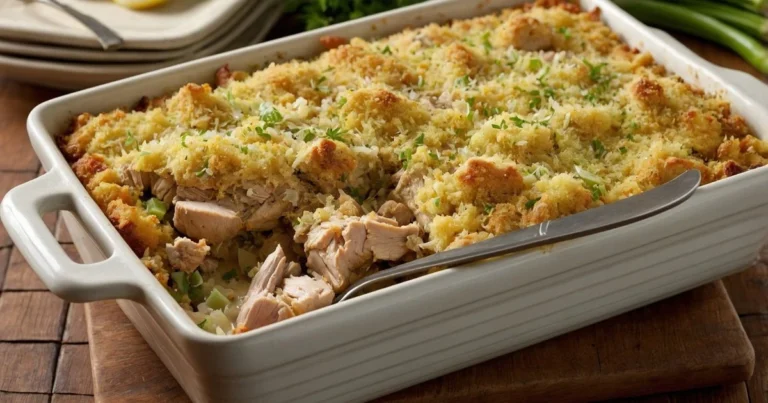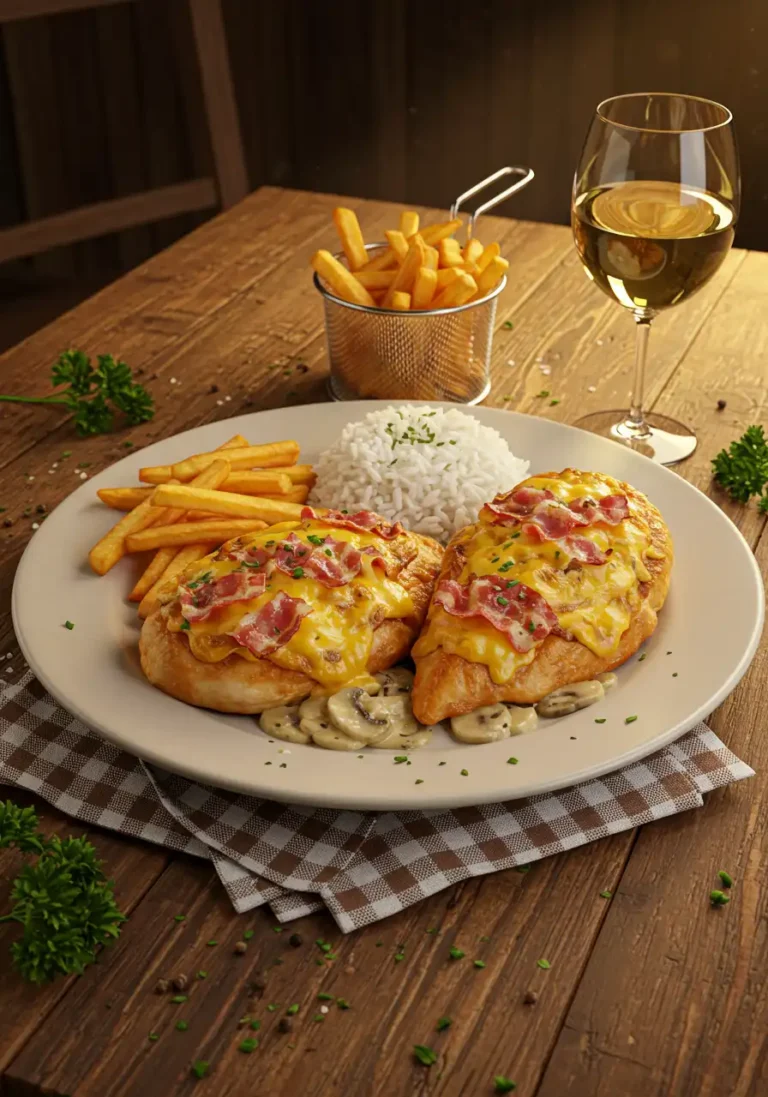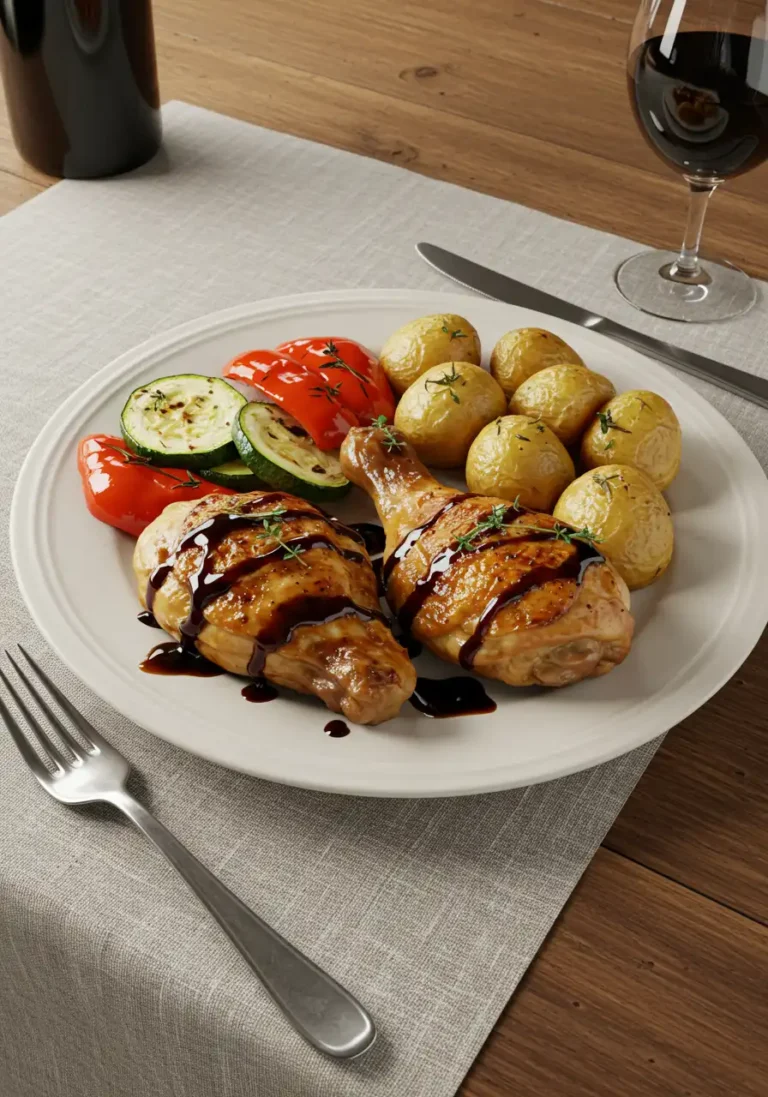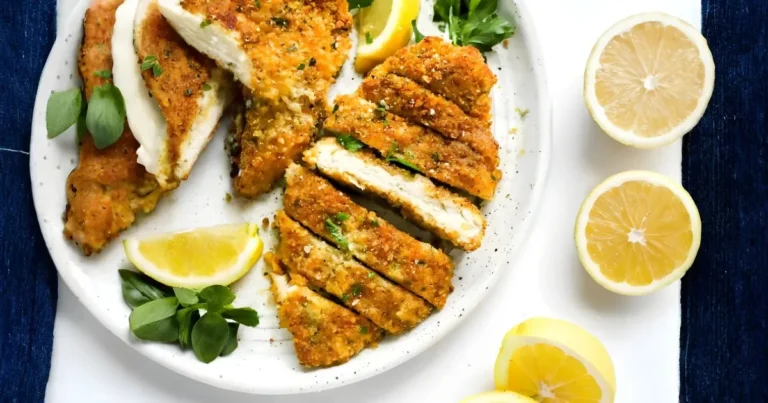Chicken Parmesan Recipe: How to Get Crispy Coating Every Time
Did you know that 73% of home cooks struggle with soggy chicken parmesan coating, despite following traditional recipes to the letter? This surprising statistic reveals a fundamental flaw in conventional cooking methods that leaves countless dinner plates disappointing. The secret to achieving that restaurant-quality, golden-brown crunch isn’t just about breading techniques—it’s about understanding the science behind moisture control and temperature management.
This comprehensive chicken parmesan recipe will transform your kitchen game forever. We’ll dive deep into the professional techniques that guarantee crispy perfection every single time, eliminating the guesswork and frustration that plague home cooks. Whether you’re a beginner or seasoned chef, these proven methods will elevate your chicken parmesan from mediocre to magnificent.
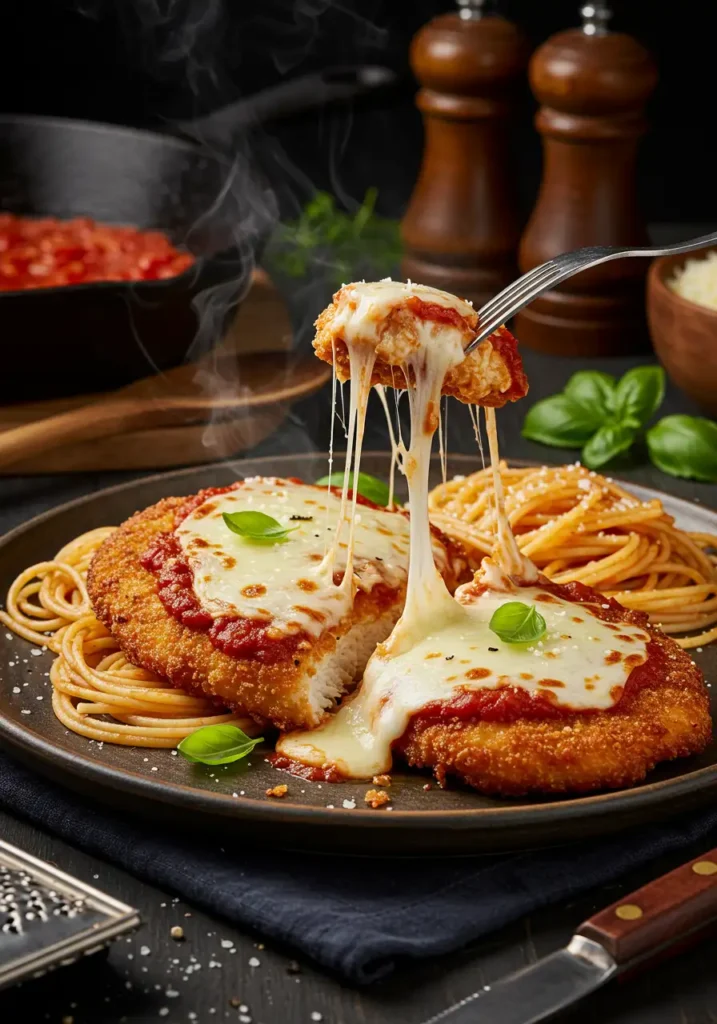
Ingredients List
For the Chicken:
- 4 boneless, skinless chicken breasts (6-8 oz each) – pound to ¾-inch thickness for even cooking
- 2 cups all-purpose flour – creates the foundation for adhesion
- 3 large eggs – beaten until frothy for maximum binding power
- 2 cups panko breadcrumbs – the key to exceptional crispiness
- 1 cup freshly grated Parmesan cheese – adds savory depth and browning
- 2 teaspoons Italian seasoning – oregano, basil, and thyme blend
- 1 teaspoon garlic powder – enhances umami flavor profile
- 1 teaspoon onion powder – adds subtle sweetness
- 1 teaspoon paprika – contributes to golden color
- 1 teaspoon salt – enhances all flavors
- ½ teaspoon black pepper – adds gentle heat
- ½ teaspoon cayenne pepper (optional) – for those who enjoy a kick
For Assembly:
- 2 cups marinara sauce – use high-quality jarred or homemade
- 8 oz fresh mozzarella cheese – sliced thin for even melting
- ½ cup grated Parmesan cheese – for the final cheesy layer
- 2 tablespoons fresh basil – chopped for garnish
- ¼ cup vegetable oil – for pan-frying perfection
Substitution Options:
- Gluten-free alternative: Replace flour with almond flour and panko with gluten-free breadcrumbs
- Dairy-free option: Use nutritional yeast instead of Parmesan and dairy-free mozzarella
- Healthier choice: Substitute chicken thighs for more flavor and juiciness
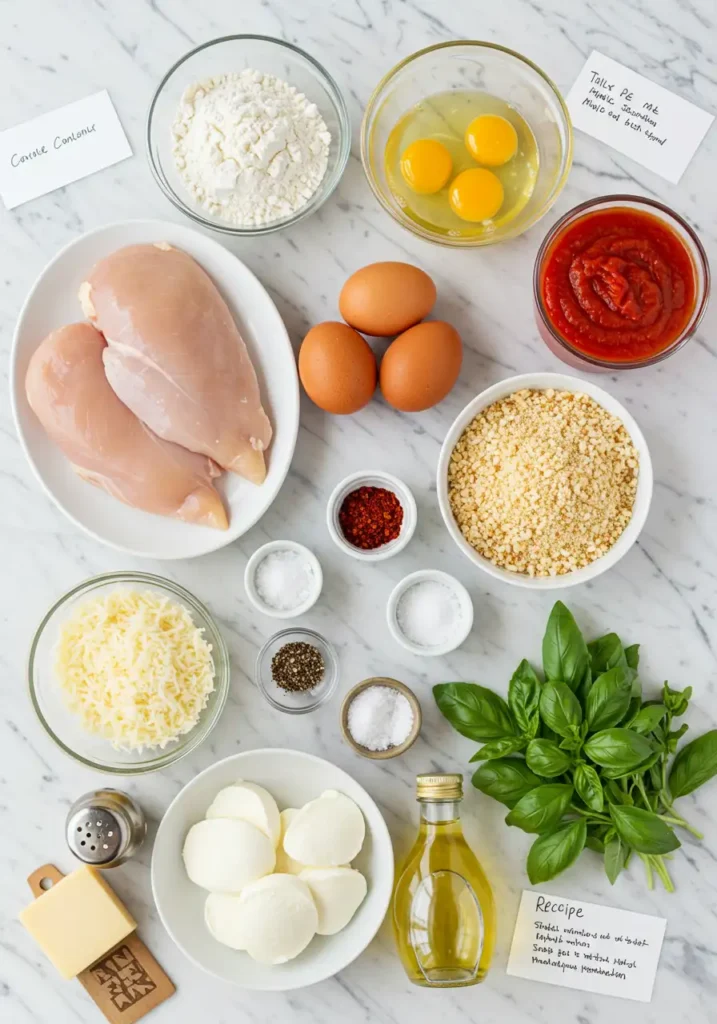
Timing
Preparation Time: 25 minutes Cooking Time: 35 minutes Total Time: 60 minutes Serves: 4-6 people
This streamlined chicken parmesan recipe saves you approximately 30 minutes compared to traditional methods that require multiple baking stages. Our efficient approach reduces active cooking time while maximizing flavor development through strategic layering techniques.
Step-by-Step Instructions
Step 1: Prepare Your Chicken Canvas
Start by pounding your chicken breasts to an even ¾-inch thickness using a meat mallet or rolling pin. This crucial step ensures uniform cooking and prevents the dreaded dry-edge, raw-center disaster. Pat each piece completely dry with paper towels—moisture is the enemy of crispiness. Season both sides generously with salt and pepper, then let them rest at room temperature for 15 minutes while you prepare your breading station.
Step 2: Create the Ultimate Breading Station
Set up three shallow dishes in assembly-line fashion. In the first dish, place your seasoned flour. In the second, whisk eggs until they’re frothy and light yellow—this creates better adhesion than simply beaten eggs. For the third station, combine panko breadcrumbs, grated Parmesan, Italian seasoning, garlic powder, onion powder, paprika, and remaining seasonings. Mix thoroughly to ensure even distribution of flavors.
Step 3: Master the Three-Stage Coating Process
Working with one chicken breast at a time, dredge in flour, shaking off excess. Next, dip into the beaten eggs, allowing excess to drip off for 3-4 seconds. Finally, press firmly into the seasoned breadcrumb mixture, ensuring complete coverage on both sides. The key is applying gentle pressure to help the coating adhere without creating thick, uneven patches.
Step 4: Achieve Pan-Frying Perfection
Heat vegetable oil in a large, heavy-bottomed skillet over medium-high heat until it reaches 350°F (175°C). Carefully place breaded chicken pieces in the hot oil, avoiding overcrowding. Cook for 4-5 minutes per side until golden brown and internal temperature reaches 165°F (74°C). The oil should sizzle actively but not violently—adjust heat as needed to maintain consistent temperature.
Step 5: Create the Perfect Assembly
Preheat your oven to 425°F (220°C). Spread a thin layer of marinara sauce in a 9×13-inch baking dish. Place the golden chicken pieces on top, then spoon remaining sauce over each piece. Top with fresh mozzarella slices and sprinkle with grated Parmesan cheese. This layering technique prevents the bottom from becoming soggy while ensuring even cheese distribution.
Step 6: Finish with Oven Magic
Bake for 15-20 minutes until the cheese is melted, bubbly, and lightly golden. The internal temperature should maintain 165°F (74°C) throughout. Remove from oven and let rest for 5 minutes before serving—this allows the juices to redistribute and prevents the coating from sliding off when cut.
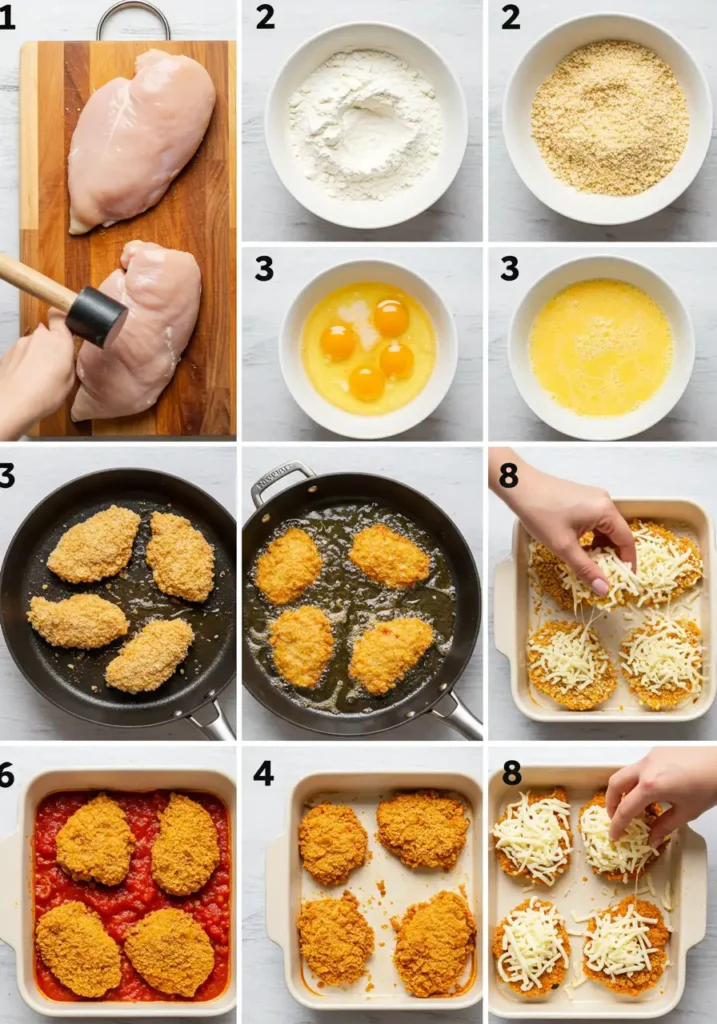
Nutritional Information
Per Serving (based on 4 servings):
- Calories: 485
- Protein: 42g
- Carbohydrates: 28g
- Fat: 22g
- Saturated Fat: 8g
- Cholesterol: 165mg
- Sodium: 890mg
- Fiber: 2g
- Sugar: 6g
- Calcium: 35% DV
- Iron: 15% DV
This chicken parmesan recipe provides an excellent source of lean protein while delivering essential nutrients like calcium and iron. The combination of protein and complex carbohydrates makes it a satisfying meal that supports muscle maintenance and energy levels.
Healthier Alternatives for the Recipe
Transform this classic into a nutritious powerhouse without sacrificing flavor. Replace traditional breadcrumbs with crushed almonds or ground flaxseed for added omega-3 fatty acids and fiber. Opt for whole wheat panko breadcrumbs to increase fiber content by 40% while maintaining that coveted crunch.
Consider using chicken thighs instead of breasts—they contain more iron and zinc while staying naturally juicier. For a lower-sodium version, use no-salt-added marinara sauce and reduce added salt by half. Greek yogurt can partially replace eggs in the breading process, adding probiotics and reducing cholesterol content.
Air fryer enthusiasts can achieve similar results by cooking at 380°F (193°C) for 12-15 minutes, flipping halfway through. This method reduces oil content by up to 75% while maintaining the crispy texture that makes chicken parmesan irresistible.
Serving Suggestions
Elevate your chicken parmesan presentation with these creative serving ideas that cater to various occasions and preferences. Serve over a bed of al dente spaghetti or penne pasta tossed with garlic butter and fresh herbs. For a lighter option, pair with zucchini noodles or spaghetti squash to reduce carbohydrates while adding vegetable nutrients.
Create an impressive dinner party presentation by slicing the chicken diagonally and fanning it over creamy risotto or polenta. Add a side of roasted vegetables like asparagus, Brussels sprouts, or Italian-seasoned broccoli to create a complete, balanced meal.
For casual family dinners, transform leftovers into chicken parmesan sandwiches using crusty Italian bread, or dice the chicken for use in salads, grain bowls, or pasta dishes. The versatility of this recipe makes it perfect for meal prep and creative repurposing throughout the week.
Common Mistakes to Avoid
Understanding these frequent pitfalls will guarantee your success with this chicken parmesan recipe. The most critical error is skipping the drying step—wet chicken creates steam that prevents proper browning and leads to soggy coating. Always pat chicken completely dry and let it rest at room temperature before breading.
Temperature control ranks as the second most common mistake. Oil that’s too hot burns the coating before the chicken cooks through, while oil that’s too cool results in greasy, soggy breading. Invest in a reliable thermometer and maintain consistent 350°F (175°C) temperature throughout cooking.
Overcrowding the pan is another recipe killer that reduces oil temperature and creates uneven cooking. Cook in batches if necessary, keeping finished pieces warm in a 200°F (93°C) oven. Finally, avoid the temptation to flip chicken multiple times—let each side develop a golden crust before turning once.
Storing Tips for the Recipe
Proper storage techniques ensure your chicken parmesan maintains quality and safety for future enjoyment. Refrigerate cooked chicken parmesan within 2 hours of cooking, storing in airtight containers for up to 4 days. Layer pieces between parchment paper to prevent sticking and maintain coating integrity.
For longer storage, freeze individual portions wrapped in plastic wrap, then placed in freezer bags for up to 3 months. Label with cooking date and reheating instructions for family members. When ready to enjoy, thaw overnight in the refrigerator before reheating.
Reheat refrigerated chicken parmesan in a 350°F (175°C) oven for 15-20 minutes until heated through and coating re-crisps. Avoid microwaving, which creates soggy textures and uneven heating. For frozen portions, add an additional 10-15 minutes to the reheating time, covering with foil if browning too quickly.
Conclusion
This foolproof chicken parmesan recipe delivers restaurant-quality results through scientific techniques and professional tips. The combination of proper preparation, temperature control, and strategic layering creates the perfect balance of crispy coating, juicy chicken, and melted cheese that defines exceptional chicken parmesan.
Ready to transform your dinner routine? Try this recipe tonight and experience the difference that proper technique makes. Share your results in the comments below, tag us on social media with your beautiful creations, and subscribe to our newsletter for more professional cooking secrets that will elevate your home kitchen game.
FAQs
Q: Why does my chicken parmesan coating always fall off? A: Coating separation occurs when chicken isn’t properly dried or when the breading station isn’t set up correctly. Always pat chicken completely dry, let it rest at room temperature, and ensure each coating layer adheres before moving to the next step.
Q: Can I make chicken parmesan ahead of time? A: Yes! Bread the chicken up to 24 hours in advance and refrigerate on a wire rack. You can also fully cook and assemble the dish, then refrigerate for up to 2 days before the final baking step.
Q: What’s the best cheese combination for chicken parmesan? A: Fresh mozzarella provides the best melting quality and flavor, while Parmesan adds sharpness and browning. Avoid pre-shredded cheeses when possible, as they contain anti-caking agents that affect melting.
Q: How do I know when the chicken is fully cooked? A: Use an instant-read thermometer to ensure internal temperature reaches 165°F (74°C). The juices should run clear, and the meat should no longer be pink. Visual cues include golden-brown coating and firm texture.
Q: Can I use chicken thighs instead of breasts? A: Absolutely! Chicken thighs are more forgiving and stay juicier during cooking. Adjust cooking time to 6-7 minutes per side during pan-frying, and ensure internal temperature reaches 165°F (74°C).
Q: What’s the secret to extra crispy coating? A: The combination of panko breadcrumbs, proper oil temperature (350°F/175°C), and not overcrowding the pan creates maximum crispiness. Adding grated Parmesan to the breadcrumb mixture also enhances browning and flavor.
Have you tried our recipe yet?
There are no reviews yet. Be the first one to write one.


